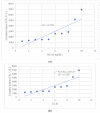Urea/Creatinine Ratio's Correlation with Creatine Kinase Normalization in Pediatric COVID-19 Patients with Myositis: Evaluating Prognostic and Predictive Value
- PMID: 38247974
- PMCID: PMC10801615
- DOI: 10.3390/idr16010002
Urea/Creatinine Ratio's Correlation with Creatine Kinase Normalization in Pediatric COVID-19 Patients with Myositis: Evaluating Prognostic and Predictive Value
Abstract
Coronavirus disease 2019 (COVID-19) has been chiefly linked with substantial respiratory complications. However, emerging studies have brought attention to the occurrence of severe muscle inflammation (myositis) related to COVID-19, potentially leading to multi-organ failure and increased mortality. Myositis is generally characterized by heightened serum creatine kinase (CK) levels. Acute myositis is characterized by an infiltration of viruses into calf muscle fibers, which may cause a subsequent inflammatory response leading to calf muscle pain. Symptomatic and supportive management, along with explanation and reassurance, is all that is required in managing this condition. While the association between myositis and severe outcomes has been recognized in adults, it remains less understood in the pediatric population. The current retrospective study, conducted at Policlinico San Marco University Hospital in Catania, aimed to analyze clinical and laboratory factors associated with myositis in pediatric patients with SARS-CoV-2 infection. Between January 2022 and January 2023, ten pediatric patients diagnosed with myositis and SARS-CoV-2 infection were evaluated. The study highlighted clinical manifestations such as fever, calf muscle pain, and abnormal gait. Lab results showed elevated CK levels among other findings. All patients underwent treatment, with the majority recovering without complications. A notable correlation was observed between CK levels, blood urea nitrogen (BUN), and the urea/creatinine ratio (UCR). The study also discusses potential pathophysiological mechanisms behind SARS-CoV-2's impact on skeletal muscles, emphasizing an indirect inflammatory response. Our findings underscore that while myositis in children with SARS-CoV-2 infection appears to follow a benign and self-limiting trajectory, it is crucial to monitor specific markers for early intervention and management. Further research is warranted to elucidate the underlying mechanisms and improve clinical outcomes.
Keywords: COVID-19 myolysis; COVID-19 myositis; SARS-CoV-2 infection; pediatric COVID-19.
Conflict of interest statement
The authors declare no conflicts of interest.
Figures




Similar articles
-
Benign acute childhood myositis in the COVID-19 Era: how does it compare to influenza?Eur J Pediatr. 2025 Apr 11;184(5):291. doi: 10.1007/s00431-025-06116-6. Eur J Pediatr. 2025. PMID: 40214813 Free PMC article.
-
Benign acute childhood myositis: importance of early recognition.Br J Nurs. 2019 May 9;28(9):560-564. doi: 10.12968/bjon.2019.28.9.560. Br J Nurs. 2019. PMID: 31070976
-
Benign acute children myositis: 5 years experience in a tertiary care pediatric hospital.Eur J Pediatr. 2023 Oct;182(10):4341-4349. doi: 10.1007/s00431-023-05115-9. Epub 2023 Jul 18. Eur J Pediatr. 2023. PMID: 37462800 Free PMC article.
-
COVID-19 and Myositis: What We Know So Far.Curr Rheumatol Rep. 2021 Jul 3;23(8):63. doi: 10.1007/s11926-021-01023-9. Curr Rheumatol Rep. 2021. PMID: 34216297 Free PMC article. Review.
-
Clinical features and follow-up of pediatric patients hospitalized for COVID-19.Pediatr Pulmonol. 2021 Jul;56(7):1967-1975. doi: 10.1002/ppul.25407. Epub 2021 Apr 14. Pediatr Pulmonol. 2021. PMID: 33852775 Free PMC article. Review.
Cited by
-
Creatine and post-viral fatigue syndrome: an update.J Int Soc Sports Nutr. 2025 Sep;22(sup1):2517278. doi: 10.1080/15502783.2025.2517278. Epub 2025 Jun 6. J Int Soc Sports Nutr. 2025. PMID: 40481620 Free PMC article. Review.
-
Case Report: Diagnosis, treatment and follow-up of venous thrombosis in adolescent diabetic patients with SARS-CoV-2.Front Pediatr. 2025 Aug 11;13:1562590. doi: 10.3389/fped.2025.1562590. eCollection 2025. Front Pediatr. 2025. PMID: 40861049 Free PMC article.
-
Association between SARS-CoV-2 infection and anti-apolipoprotein A-1 antibody in children.Front Immunol. 2025 Feb 26;16:1521299. doi: 10.3389/fimmu.2025.1521299. eCollection 2025. Front Immunol. 2025. PMID: 40079006 Free PMC article.
References
-
- Vaira L.A., De Vito A., Deiana G., Pes C., Giovanditto F., Fiore V., Lechien J.R., Saussez S., Policicchio D., Boccaletti R., et al. Systemic Inflammatory Markers and Psychophysical Olfactory Scores in Coronavirus Disease 2019 Patients: Is There Any Correlation? J. Laryngol. Otol. 2021;135:723–728. doi: 10.1017/S0022215121001651. - DOI - PMC - PubMed
-
- Zinellu A., De Vito A., Scano V., Paliogiannis P., Fiore V., Madeddu G., Maida I., Zinellu E., Mangoni A.A., Arru L.B., et al. The PaO2/FiO2 Ratio on Admission Is Independently Associated with Prolonged Hospitalization in COVID-19 Patients. J. Infect. Dev. Ctries. 2021;15:353–359. doi: 10.3855/jidc.13288. - DOI - PubMed
-
- Campanella E., Marino A., Ceccarelli M., Gussio M., Cosentino F., Moscatt V., Micali C., Nunnari G., Celesia B.M., Cacopardo B. Pain Crisis Management in a Patient with Sickle Cell Disease during SARS-CoV-2 Infection: A Case Report and Literature Review. World Acad. Sci. J. 2022;4:1–5. doi: 10.3892/wasj.2022.149. - DOI
LinkOut - more resources
Full Text Sources
Research Materials
Miscellaneous

